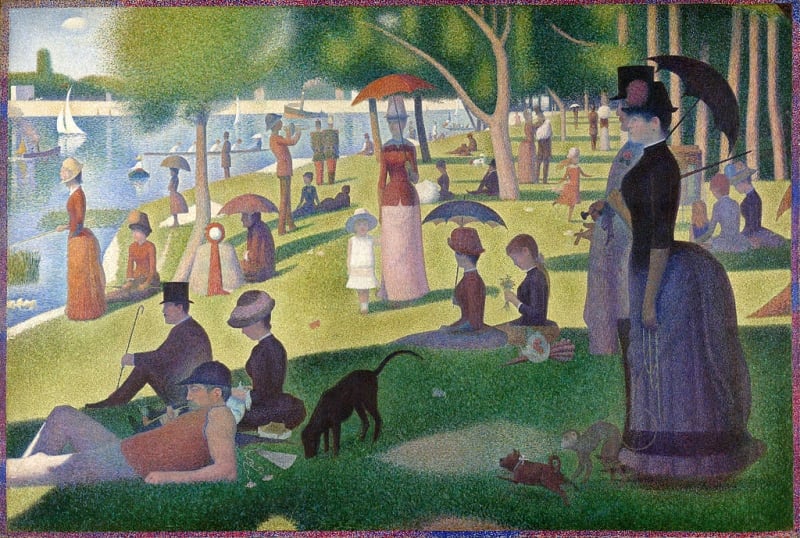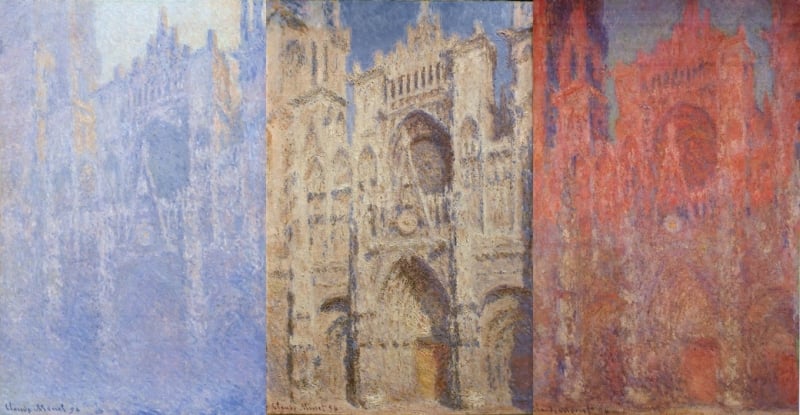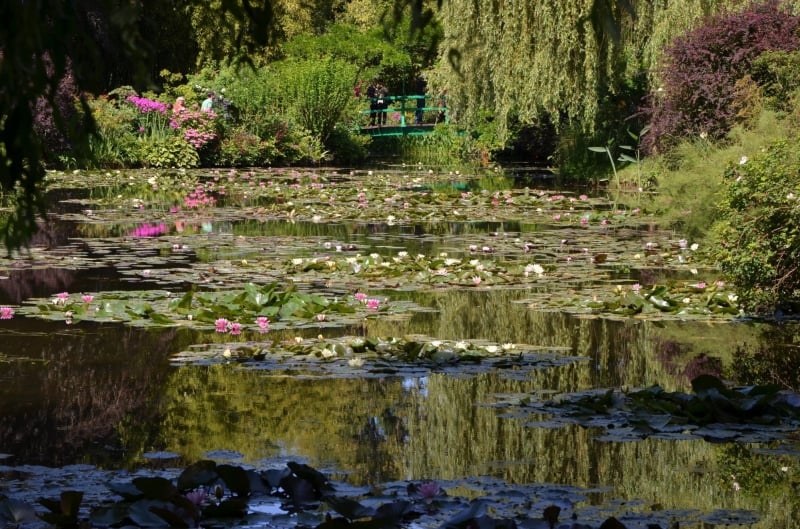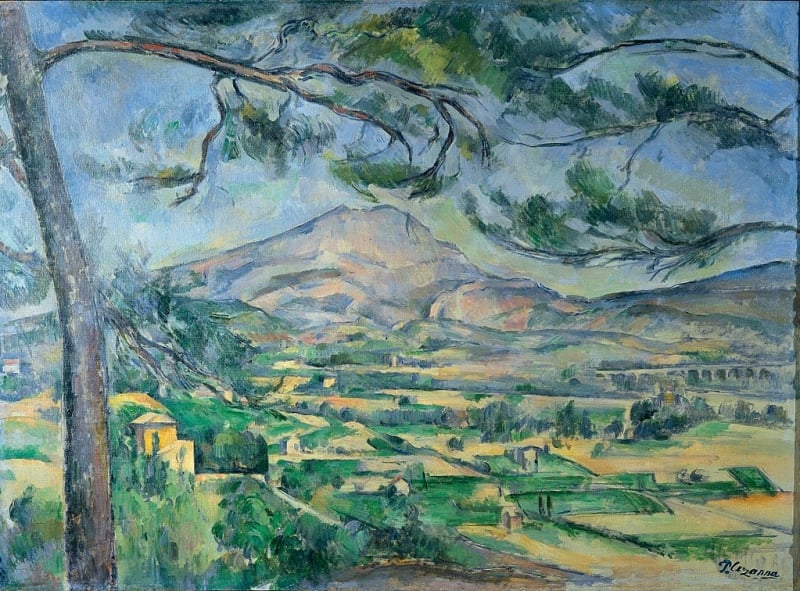Allez les Bleus!
While the French may be champions at this year’s World Cup, the nation has had a larger reputation as a champion of the arts. With canonical figures in both artistic and literary tradition, the French have made substantial contributions to the long history of Western art and culture.
Let this list of ten important French paintings take you through an exciting period in art history. Along the way, visit the real locations in France that inspired these artworks. Embark on a journey that begins in everyone’s favourite City of Light, Paris, and which ends in the sun-drenched French Riviera.
Who knows, you might just be tempted to pack your easels and brushes for a trip to France, and try your hand at painting en plein air (in the open air), as the Impressionists famously did!
Paris
1. La Musique aux Tuileries (1862), Édouard Manet

Before scandalizing the art world with his famous Le déjeuner sur l’herbe, and later, Olympia, there was Manet’s equally provocative Music in the Tuileries.
Although the bustling scene of a music concert at the Tuileries Garden might seem like an innocuous subject to modern viewers, the work was considered radical for its time in its attempt to depict urban leisure, a subject matter generally considered unworthy of high art. The work is now displayed in The National Gallery, London.

Image credit: Gala Medina
Located between the iconic Louvre and the Place de la Concorde, the Tuileries Garden also carries its own historic weight. Initially created for the exclusive use of the royal court, the expansive Garden has been made public since the 17th century, and forms the backdrop for multiple historic events spanning modern French history.
As Manet’s painting suggests, the Garden was the centre of festivities and entertainment in the late 19th century. Today, it remains a lavish public garden open for flâneurie, or the leisurely act of strolling through urban locales.
2. Bal du moulin de la Galette (1876), Pierre-Auguste Renoir

A snapshot of urban Parisian life: this is what Renoir immortalizes in his famed Dance at Le moulin de la Galette, completed in 1876. A monumental work of Early Impressionism, the masterpiece depicts a Paris filled with exuberant romance. The work is now displayed in the Musée d’Orsay, Paris.

Image credit: Giorgio Galeotti
Located in the historic district of Montmartre, the Moulin de la Galette was a celebrated restaurant and dance-hall in the late 19th century, where the city’s biggest entertainment-seekers would gather to party the night away with wine and galettes. Now a contemporary bistro, the iconic windmill marks its entrance and continues to rival Montmartre’s other famed windmill, the Moulin Rouge.
3. Un dimanche après-midi à l’Île de la Grande Jatte (1884), Georges Seurat

As its name suggests, Georges Seurat’s painting depicts a relaxing Sunday afternoon spent on the islet of La Grande Jatte, located in the River Seine to the northwest of Paris.
Using dots of complementary colours that solidify into vivid forms when seen from a distance, Seurat’s pointillist technique established a methodical style that distinguished the Neo-Impressionists from the spontaneity of the Impressionists. The work is now displayed in the Art Institute of Chicago.

Image credit: Tos
Providing a quiet respite from the ceaseless hubbub of Paris, this suburban islet is now home to luxurious apartments and their affluent owners. Beyond Manet, the islet has inspired the works of Claude Monet and Vincent van Gogh, among others, accruing an impressive artistic reputation that continues to attract locals and tourists alike.
Rouen
4. Rouen Cathedral series (1892-1894), Claude Monet

From misty mornings to glowing sunsets, Claude Monet’s Rouen Cathedral series consists of 31 canvases depicting the same subject — the portals of the cathedral — as viewed at various times of the day and year.
Colours here shift perceptibly across each painting, yet adhere always to the eye’s perception of form and light. With the series, Monet achieved an unprecedented balance in the Impressionist’s quest to capture the instantaneous, as set in tension against the transient nature of all existence. While individual works are scattered in museums across the world, the Musée d’Orsay in Paris boasts an impressive number of these paintings.
Once a major European city in medieval times, the city of Rouen is now the capital of the Normandy region in northern France and is well-known for the stunning cathedral towering high above the cityscape. A fine example of church architecture constructed in the Gothic tradition, the impressive cathedral has inspired not only famous painters like Monet but also great French literary figures, such as Gustave Flaubert and Joris-Karl Huysmans.
Giverny
5. Nymphéas, or Water Lilies series (1897-1926), Claude Monet

Perhaps the most celebrated paintings of the 20th century, Monet’s Water Lilies series comprises 250 canvases depicting landscapes of the eponymous flowers in his garden ponds, occasionally framed by the Japanese bridge installed in the garden. Captured at varying times of the day, the series epitomises the Impressionist’s sensitivity to fleeting moments, while the deft play of light and colour further lends a spiritual tenor to the canvas.
This particular work is now displayed in the Art Institute of Chicago, but many more are found in major museums around the world. The monumental versions located in Musée de l’Orangerie in Paris are displayed according to directions given by Monet himself, providing an especially awe-inspiring experience.

Image credit: CpaKmoi
A small commune in the Eure department of northern France, the village of Giverny was home to Monet for the last 30 years of his life. Now a museum dedicated to the artist, Monet’s property in Giverny is open to visitors eager to look upon the famed water lilies as he once did.
Feel free to roam around the Japanese-inspired water garden that Monet designed, complete with a reconstructed Japanese bridge. With the calm environs reflected upon the still surface of the lily pond, the flowers continue to captivate even after a century since Monet eternalised them.
Marseille
6. Le golfe de Marseille vu de L’Estaque (1885), Paul Cézanne

A recurrent motif in Paul Cézanne’s body of work, this panoramic view of the bay of Marseille, as seen from the seaside village of L’Estaque, exemplifies the artist’s movement away from Impressionism.
Indeed, with distinct, deliberate brushstrokes working up towards complex silhouettes, the above painting solidifies Cézanne’s reputation as a Post-Impressionist and the father of Modern art. The work is now displayed in the Art Institute of Chicago.

Image credit: Eden G
Once an important port linking the French Empire to its North African colonies, Marseille today is the second largest city in the nation after Paris, and continues to be its largest port for commerce. As an echo of its history, the city houses significant communities of immigrants from the nation’s erstwhile colonies.
In close proximity to the ever popular Riviera of southeastern France, Marseille boasts its own array of seaside attractions. Check out the historic Old Port, with its mouth flanked by two 17th-century forts. Or else, take in breathtaking views of the city from the Palais du Pharo, or better yet, from atop the Basilique du Notre-Dame de la Garde.
If the city isn’t enough, there are day trips to view the geographical formation of the Calanques, or the Château d’If, a historic prison-fortress set on an island. Upon your return to Marseille, be sure to treat yourself to some sumptuous bouillabaisse for dinner.
Aix-en-Provence
7. Mont Sainte-Victoire series (1882-1906), Paul Cézanne

Arguably the more famous subject of Cézanne’s paintings, the Montagne Sainte-Victoire as it looms over the artist’s hometown of Aix-en-Provence would be a scene he frequently returns to in the very last years of his life.
Much like Monet’s Rouen Cathedral series, the consistent viewpoints portray the mountain as viewed under changing lights. While the masterful strokes and colours always come together to convey a distinguished atmosphere, the flatness of paint, as is characteristic of Cézanne’s style, reminds the viewer of the rough surface that underlies the images themselves. This particular rendition is now displayed in The Courtauld Gallery, London.

Image credit: Miguel Virkkunen Carvalho (left), Finn Terman Frederiksen (right)
Founded by the Romans who discovered its thermal springs, the quaint city-commune of Aix-en-Provence is best known as the hometown of one Paul Cézanne. Nevertheless, the town provides charming activities for tourists — stroll down the wide avenue of the Cours Mirabeau, or visit the Deux Garçons, a brasserie which counts Émile Zola and Ernest Hemingway among its famous patrons.
If not, go on a little hunt for the beautiful fountains scattered around town, the reason why Aix is also known as the City of a Thousand Fountains. Above all, visit Cézanne’s atelier via a short climb uphill along Les Lauves. In close proximity is also the Terrain des Peintures, a terraced garden from which Cézanne painted the Montagne Sainte-Victoire — have a picnic here and soak in the view forever glorified on canvas.
Saint-Tropez
8. Port de Saint-Tropez (1901-1902), Paul Signac

Deeply affected by the early death of Georges Seurat, who helped developed the Neo-Impressionist technique of pointillism, Signac embarked on a short voyage around the Mediterranean and discovered Saint-Tropez, the then small fishing village which he would repeatedly return to in the next decade.
The work represents Signac at the height of his abilities, with soft lines and prominent, contrasting dots recreating the warm Mediterranean light of Saint-Tropez. It is now displayed in The National Museum of Western Art, Tokyo.

Image credit: Juan Rubiano
Today, Saint-Tropez is synonymous with glamourous excess, exuding a sizzling sexiness that can only be attributed to 50s screen goddess Brigitte Bardot and her role in the wildly successful 1956 film, And God Created Woman.
In fact, in 2017, the town announced that a statue of Bardot will be erected in honour of the woman who made Saint-Tropez, well, Saint-Tropez: a premier, jet-setting destination for Hollywood A-listers.
Indeed, you’ll be hard-pressed to miss the expensive yachts lining Saint-Tropez’s Vieux Port, or the luxury boutiques in La Ponche, the historic Old Town. For picturesque views of the sea under the Côte d’Azur sun, climb up the Citadelle de St-Tropez, which now also serves as a maritime history museum.
Speaking of sun, go get yourself a gorgeous tan at Saint-Tropez’s public beaches, and in the meantime, who knows, you might just spot some millionaire film stars!
Nice
9. La Baie de Nice (1918), Henri Matisse

An innovative colourist that transformed the face of modern art, Henri Matisse was a leading figure in Fauvism, which favoured the use of bright, strong colours and deliberate, gestural brushstrokes.
As the translation of fauves implies, Matisse’s works were “wild beasts”: expressive canvases that exude a primitive energy even through tranquil scenes like the one above, which depicts the Baie des Anges as seen from a balcony in Nice. The work is currently held in a private collection.

Blessed with more than 300 days of sun a year, nothing defines the French Riviera quite like Nice. Beyond splendid sunlight, its yellow and ochre buildings radiate an old-world appeal, sporting Italian influences in its architecture to Niçoise cuisine (ratatouille, anyone?).
Enjoy the sun on the Promenade des Anglais’ iconic blue chairs, or else shop for fresh produce and flowers by the Cours Saleya, a marketplace doused in local light and colour. The whole of Nice is laid out like an amusement park: from the checkered tiles at the Place Masséna to the green playgrounds of the adjoining Promenade du Paillon, Nice encourages plenty of fun apart from its famous beaches.
To watch beach-goers lounging in the sun, or the shadow of planes gliding across clear waters, climb winding steps up to the top of the Colline du Château — or cheat by taking a free lift directly up to the park.
Nice is also home to at least two museums dedicated to important artists: the Musée Matisse and the Musée Marc Chagall, the second containing a significant collection of the Russian painter’s religious works.
Arles
10. Café, le soir (1888), Vincent van Gogh

While technically not of French origin, we will be forgiven for including this sublime picture by Dutch painter Vincent van Gogh, depicting the glowing interiors of a café in Arles set against the deep blue of the night sky. First in his oeuvre to employ a nocturnal backdrop, the painting also prefigures van Gogh’s celebrated The Starry Night.
With a flurry of brushstrokes in pale yellows and greens, van Gogh here achieves a luminescence that positively radiates from the canvas, conveying a spiritual warmth that distinguishes the work from its Impressionist predecessors. An eternal #mood, this work is now displayed in the Kröller-Müller Museum, Otterlo, the Netherlands.

Image credit: Palickap
While van Gogh’s residence in Arles is the city-commune’s main claim to fame, the town located in southern France is also known for its Roman ruins. In fact, the Roman and Romanesque Monuments of Arles is a UNESCO World Heritage site of special interest to classical historians and archaeologists.
Otherwise, Arles is the pilgrimage destination for van Gogh fans, who flock to Le Café La Nuit at 11 Place du Forum to spend an evening under a starry sky. The café’s exterior has long since been renovated and decked out to look exactly like it does on canvas.
In a letter addressed to his brother, van Gogh proclaims that “painters understand nature and love it, and teach us to see”. Certainly, art is often evocative of an ecstatic experience translated on canvas — it inspires us to travel, to witness with our own eyes the beauty of places that have so enraptured an artist’s imagination.
And so, there you have it. Ten paintings, ten places: there could be no better reasons than these to seek out beauty both on canvas and in real life, and in so doing, to immerse in culture à la française!






